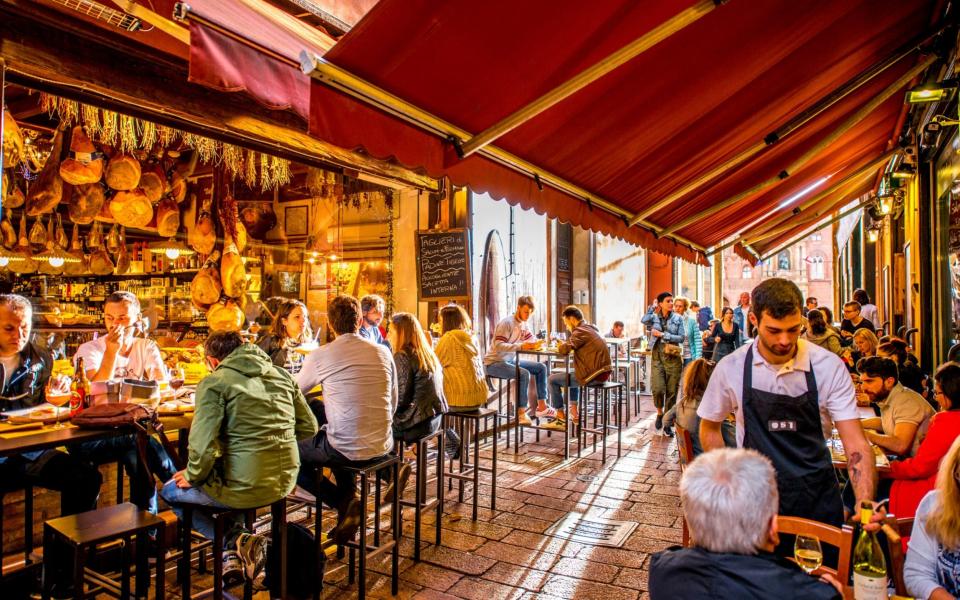Italy's al fresco restaurant culture can teach us a lot about how to dine outdoors

Tuscan-born Giancarlo Caldesi and his wife Katie own London's Caldesi in Marylebone, Caldesi in Campagna in Bray, and the Marylebone La Cucina Caldesi cookery school. Together they have written nine cookbooks on the food of regional Italy – and enjoyed decades of Italian hospitality, al fresco...
Across Italy, signs of the pandemic are – at long last – beginning to fade to the tune of six o’clock aperitivos. Restrictions still apply – discreet dots mark the pavements, setting out the allowed areas for restaurants to set out tables and chairs, and not everyone is able to leave lockdown – but after months, the famous Italian tradition of al fresco dining is coming alive once more. Although it is impossible to recreate the atmosphere of the piazza on a balmy evening, Brits could learn a thing or two from it.
Restaurants all offer table service, each establishment usually serving their own collection of tables only. You don’t get a coffee from one place and then a doughnut from another – that’s a very modern concept. We went to Florence recently and visited a space above the market where a communal table arrangement had been set up, but this is not traditional.
In the morning, it’s a quicker process. You’ll see people standing at the bar or sitting outside with a quick cappuccino and perhaps a cornetti – what Italians call a croissant – or a doughnut. Even then the atmosphere is jolly; everyone knows everyone, and they all want to talk and to gossip, to exchange recipes for the dinner they had last night. The cappuccino is always served tepid, so that you can drink it fast if you’re in a hurry. Many restaurants provide coverings made from cane, which shade people from the sun and allow the breeze to flow through the space; they’re much better than umbrellas, which can be stifling.
Six o’clock in the evening, though, is the big event. It is too hot to go out during the daytime in Italy, so everyone waits until the evening, when each bar will serve aperitivos. To drink, it’s an Aperol spritz or Bollicini prosecco with nibbles. In Venice, men used to sell wine under the shade in St Mark’s Square, pouring glasses from their barrels, which would serve as a table for the customer. This was the earliest version of an outdoor bar, known as an ombra, meaning ‘shade’. When you pop out for a drink in Venice, you would say you're ‘going for an ombra’ or ‘ombrina’.
But Italians don’t just go for a drink, that is a very British concept. They go out to eat. A finger buffet of delights comes with your drink, all included in the price. Some restaurants do it fantastically, some buy in frozen food; you have to find the right one. In Palermo, you might have plates of arancini, panelle and panino di milza – small loaves of bread stuffed with spleen. In Rome, pizza Romana by the slice, beef meatballs and suppli – lozenges of rice stuffed with tomato and oozing melted cheese. In Tuscany, we had bruschetta with black kale and beans with fantastic olive oil. And in Venice, they serve deliciously over-stuffed sandwiches, filled with artichoke, mayonnaise and egg. Venice is famous for its exquisite cicchetti.

Though al fresco dining has traditionally been a summer thing, increasingly Italian restaurants provide outdoor seating throughout the winter, too. We spent Christmas in Venice, and even then people were sitting outside with a glass of prosecco. The idea possibly came from Italian ski resorts, which are more equipped for catering for outdoor winter dining. Now when you walk around Rome, you see restaurants with large gazebos and heaters for people to sit outside.
In Britain, we need to learn to use the space we have, and to take a moment to enjoy it. Pub culture traditionally stems from people not having fires in their homes, and instead seeking out a pub with a huge hearth to warm up. With space comes the ability to slow down, to have patience and enjoy sitting with a drink and something to nibble, rather than jostling inside for a pint. The pandemic has forced so many people to stop and reflect on their lives pre-Covid, and here we have the chance to change our attitude towards eating out.
We hope that the long period of time with no restaurants, pubs, cafes or bars will make people realise how important these spaces are, and to really appreciate them for what they do. Italians really relish going to a place and soaking up the atmosphere, talking to the waiter, and watching the food being prepared by experts. We are lucky that our Marylebone restaurant has a beautiful garden, and so we are able at the moment to take bookings at a reduced capacity, but we only want to do this if we can ensure that we can provide the atmosphere and experience that people want.
Every place has its own way of enhancing outside life, and that’s what has made eating out in Italy so exciting and varied. It’s always simple; honeydew melon with wonderful cured ham; watermelon with pecorino and honey. Simple, delicious, and relaxed. It’s a weather-driven feeling of gioia di vivere, spurred on by delicious food and drink.
In a post-Covid world, perhaps more space outside will suit the UK dining scene – but first, everyone must learn to relax and enjoy watching the world go by, preferably with a coffee and a plate of something sweet.

 Yahoo News
Yahoo News 
